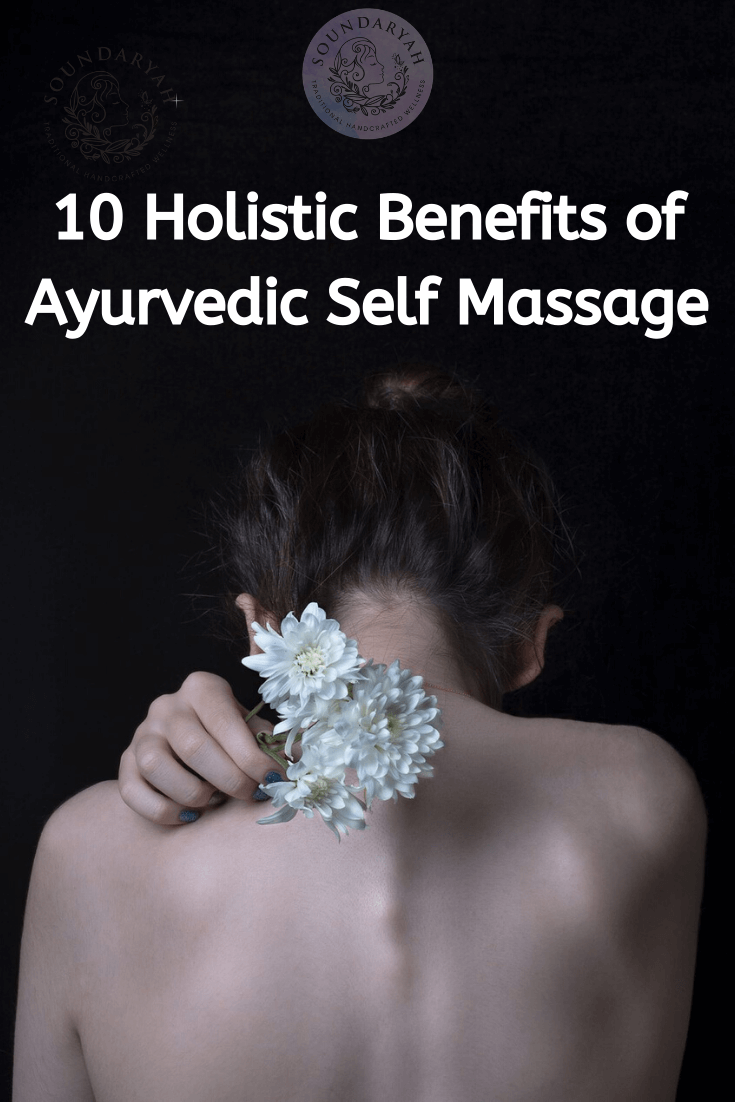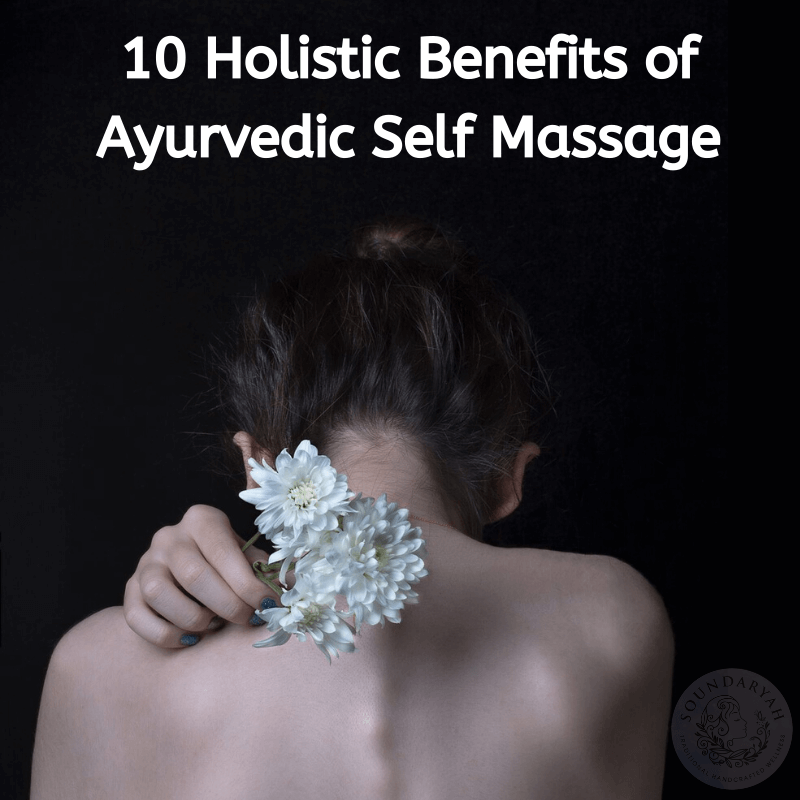Give yourself the luxury of self love and self care at home, with these holistic benefits of Ayurvedic Self Massage
When we think of a massage, what comes to mind is a quiet, dimly lit room with soft music playing in the background, and a masseuse working her way to remove all the tightness and stress in our body. It may seem like a distant dream, or something to do on your next vacation. It may also trigger anxiety thinking about how much it’s going to cost!
Popular culture and social media have create the image of massage as a luxury treat reserved for the rich and famous. However, if you go to the roots of Ayurvedic massage, you’ll find that it’s exactly the opposite. According to Ayurveda, massage is something you can do every day, in the comfort of your own home and without another person’s help. That last bit may sound tricky, but that’s where the concept of self-massage comes into the picture.
What is Ayurvedic Self Massage?

On the surface, the meaning may appear obvious – massaging yourself. However, according to Ayurveda, self-massage is a ritual that involves all your senses, and is as much for your mind as for your body. It isn’t just smearing oil over yourself – this is a much more spiritual practice with therapeutic benefits.
In Ayurveda, self-massage is referred to as ‘abhyanga’. Abhyanga is comprised of two words ‘abhi’ and ‘anga’, meaning ‘towards’ and ‘movement’, respectively. Ayurvedic self-massage is about using oil in continuous movements over your body, focusing on the body’s energy points or Marma.
The oil plays an important role in abhyanga. It’s not only about making the massage flow smoothly, the choice of oil can impart certain medicinal benefits and takes the massage to a much higher level. In fact, the word used for oil in Sanskrit is ‘sneha’, which also means ‘love’. It refers to the feeling of being saturated with oil as well as love. Now you see why abhyanga is different from regular massages!
The skin is the largest organ of our body, and applying oil all over it helps the body absorb its goodness and offer us all kinds of healing benefits. Here is a look at some of the holistic benefits of Ayurvedic self massage.
10 Holistic Benefits of Ayurvedic Self Massage

1. Balances the Doshas
In Ayurveda, the dosha refers to our constitution, or energy. There are three doshas – Kapha, Pitta and Vata, and an imbalance can cause various illnesses and a general feeling of being unwell. Ayurvedic self-massage is excellent for balancing all the doshas.
Abhyanga helps clear blockages in the body’s energy channels, which may be causing sluggishness and a lack of enthusiasm. To get the best results for your individual body constitution, it’s recommended to use the right oil – sesame oil for Vata dosha, coconut oil for Pitta dosha and almond oil for Kapha dosha.
2. Improves the appearance of skin

Considering the first point of contact in a massage is the skin, it’s obvious that the benefits start here as well! In Ayurveda, the skin isn’t just an organ on its own; it’s also the path to our internal organs and overall wellbeing.
Massaging the skin increases blood flow to all parts, and reduces cellulite and wrinkles. The idea of using a roller on the face has become a trend now – it’s something Ayurveda has been saying for centuries!
Massaging the skin with the right kind of oil also tackles scars and hyperpigmentation, improving the complexion of the skin and giving it that beautiful glow. Self-massage is an excellent anti-ageing technique, as dull skin looks more youthful and vibrant.
Besides repairing the skin and making it softer, abhyanga also protects the skin from external elements like harsh weather or environmental pollutants.
3. Makes hair healthier

Self-massage is usually divided into three parts – the head, the body and the feet. This is because the energy points on the head and feet require special attention devoted to them. Massaging the head is great for increasing circulation in the scalp, which in turn nourishes the follicles and improves hair growth.
Massage also stimulates the production of natural oils in our scalp, preventing dryness and scalp infections. It promotes lustrous hair, making it grow thick as well as soft and healthy. Using special oils can take care of specific hair concerns as well as generally improving the texture of hair.
4. Improves muscle tone

If you’ve ever had a massage, you may have noticed how it felt like all the tight knots in your body were getting loosened with every stroke. This is just one of the benefits of massage. The muscle toning benefits of abhyanga are great for people who are hunched up in one position all day, as well as people who suffer from muscle-related injuries.
Properly done self-massage releases the tightness of stiff muscles, and helps relax them, improving mobility and flexibility. It also helps strengthen muscles, improving the tone and making them firmer.
Studies have shown that doing self-massage before any kind of stretching improves the range of the stretch. Abhyanga is also known to improve balance and muscle co-ordination.
5. Reduces pain

Besides, relieving tight muscles, abhyanga or self-massage also helps with pain relief. Studies have shown how gentle massage reduces pain due to chronic illnesses like arthritis or fibromyalgia by as much as 54%.
Massage helps lubricate the joints, making them move easier, thus reducing pain. It promotes self-healing in the body, reducing inflammation. Studies have shown that performing abhyanga greatly improves symptoms associated with osteoarthritis in women.
6. Increases circulation

It is a well known fact that massage promotes good blood circulation in the body. However, Ayurvedic self massage takes this benefit to another level. Enhanced circulation ensures that nutrients and oxygen are delivered to all parts of the body in the right amount by expanding blood vessels and speeding up blood flow.
Abhyanga also reduces resistance in the arteries, which helps lower blood pressure. It stimulates the internal organs, making them perform at their maximum potential. Other benefits of improved circulation are more energy and stamina, hormonal balance, better vision and increased longevity.
7. Aids detoxification

Detoxification is a popular buzzword and there are many kinds of food and drink that claim to detox the body. However, an easy, economical and effective way to do this is with self-massage, which ensures detoxification through lymphatic drainage.
The lymphatic system removes wastes from the body. If this system is sluggish or not working properly, the accumulation of fluid can cause swelling or lymphedema. The pressure exerted through massage helps in draining this accumulated impurities and toxins. This can also help with weight loss in some cases.
8. Calms the mind

Everyone says they feel great after a massage, and it’s true! A massage can improve the health of the nervous system, helping people deal with conditions like anxiety or depression. Abhyanga gives the feeling of warm hugs and peace, instantly reducing feelings of worry.
Stress affects the body emotionally as well as physically. It affects heart rate and can lead to chronic illnesses. Studies have shown that abhyanga decreases stress levels, improves heart rate and promotes relaxation. The use of aromatic oils also enhances the experience. One study found that abhyanga reduced illness-associated depression by 40%.
9. Improves sleep

A direct benefit of reduced stress is better sleep. We are aware of the importance sleep has on overall health and wellbeing, and poor sleep is the bane of modern times. Abhyanga helps cure insomnia, and also promotes longer and deeper sleep so you wake up refreshed.
Self-massage gives that grounding feeling that results in improved sleep patterns, especially when using calming oils like sesame. One study found that a 15 minute foot massage before bed helped in falling asleep 68% faster, and resulted in fewer night time awakenings.
10. Encourages Self Love

As mentioned earlier, ‘sneha’ means both oil and love in Sanskrit. This only goes on to show that self-massage is an act of self-love, as you take the time out of your day to focus exclusively on yourself and nothing else.
Through self-massage or abhyanga, you pay attention to every part of your body, so you are immediately aware if you notice anything different. It results in renewed appreciation of your body and yourself, and also increases mindfulness – a valuable thing in busy times.
Ayurvedic self-massage or abhyanga can be performed in the morning or before bed, but it is usually done before a shower so you can clear off the excess oil. It is recommended to spend at least 15 minutes on the massage, and use an oil that is suited to your constitution and warmed to a comfortable temperature.
Abhyanga is not recommended during menstruation or any kind of illness. It is also not recommended during pregnancy or if any part of the body is injured or the skin is broken. By doing it correctly and at the correct time, you can experience the luxury of massage within your own home, and enjoy it as a special ritual exclusively for yourself.

Did you find our “10 Holistic Benefits of Ayurvedic Self Massage” interesting, please let us know in the comments section.
For more interesting updates do follow us on Facebook and Instagram.


 Verified Purchase
Verified Purchase




![Youthful Glow Herbal Face Wash [100g] - Soundaryah](http://soundaryah.com/cdn/shop/products/1a_b5d64eda-7417-41b9-bad5-b271f4ef68ff_300x.jpg?v=1634899930)
![Royal Herbal Hair Wash [200g] - Soundaryah](http://soundaryah.com/cdn/shop/products/1_300x.jpg?v=1669120964)
![Intensive Body Polishing Ubtan [200g] - Soundaryah](http://soundaryah.com/cdn/shop/products/1a_8728dcb7-c696-447d-b42e-0a56a5326fb6_300x.jpg?v=1634899848)